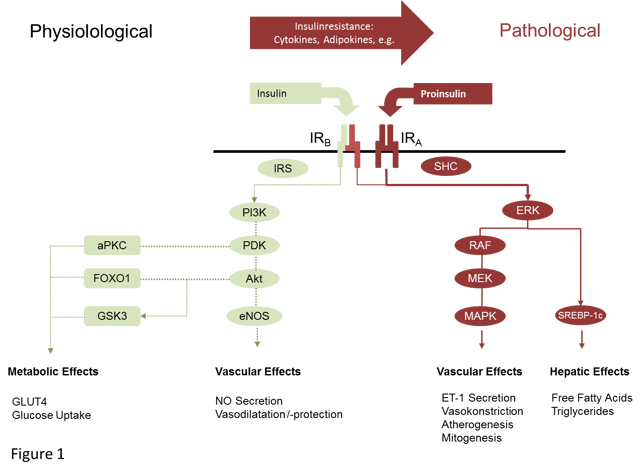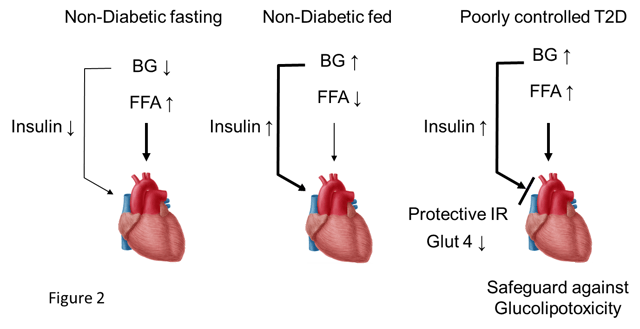Insulin resistance - What is it and why is it relevant
Worldwide, the incidence of insulin resistance (IR) is increasing due to increasing lifespan, lifestyle habits, environmental conditions and over-nutrition. In insulin resistant subjects, insulin secretion from the beta cell is augmented to overcome insulin resistance and maintain the blood glucose level in a physiological range. Merely twenty percent of these subjects will develop increased blood glucose concentrations, and will carry on to the manifestation of overt diabetes mellitus [1-4]. Normal glucose control will be maintained until functional abnormalities in insulin secretion from the beta cell will add on to the underlying insulin resistance and will merge in to loss of metabolic control and T2DM [5,6]. From this pathophysiological sequencing, T2DM can be seen as an end stage disease driven by progressing insulin resistance and set off by the failure of the beta cell to compensate for the increased insulin demand.
Insulin resistance not only increases the risk for T2DM, but also drives the development of arterial hypertension, dyslipidaemia, inflammation and coagulation disorders, causing atherosclerosis and the development of major vascular complications [7-11].
Insulin signalling - Understanding the pathways behind insulin resistance
The biological effects of insulin are mediated by specific insulin receptors. Great progress has been made in understanding the intracellular signal transduction pathways in both molecular and physiological contexts. Activation of the insulin receptor (IR) in insulin target cells initiate a complex downstream signalling cascade, which involves several distinct intracellular pathways. The insulin receptor (IR) phosphorylates at least nine intracellular signalling molecules including four different insulin receptor substrates (IRS), where IRS- 1 and IRS- 2 are suggested to serve as the major intracellular downstream signals for the insulin response [12]. In muscle cells, activation of IRS-1 and the phosphatidylinositol-3-kinase (PI3K) signalling pathway triggers the translocation of the glucose transporter (GLUT) 4 into the cell surface, enabling cellular uptake of glucose molecules. Within the liver, IRS-1 has been more closely linked with glucose homeostasis, whereas IRS-2 may be more closely linked with lipid metabolism [13]. In endothelial cells, the activation of IRS-1 and the PI3K signalling pathway increases the expression of endothelial nitric oxide synthase (eNOS) and triggers the release of nitric oxide (NO) [14-16]. NO stimulates the guanylate cyclase promoting vasodilatation and anti-proliferative effects on vascular smooth muscle cells. In addition, nitric oxide mediates anti-inflammatory effects, inhibits platelet aggregation [17,18], and reduces the expression of vascular adhesion molecules like VCAM-1, ICAM-1, or E-Selectin [19]. Therefore, activation of the PI3K signalling in endothelial cells will exert vasodilating and anti-atherogenic effects. Under certain conditions, insulin may activate alternate signalling pathways like the mitogen activated protein kinase cascade (MAPK) pathway in endothelial cells, or the transcription factor sterol regulatory element binding protein (SREBP)-1c in the liver, accounting for endothelial dysfunction and some of the lipid abnormalities observed in patients with IR [20,21].

Figure 1: Schematic presentation of intracellular insulin signalling in difference tissues. Presentation of PI3K and MAPK signalling cascades following binding of insulin to the insulin receptor subtype B. Mediators released from the visceral adipose tissue shift intracellular insulin signalling from the PI3K signalling to the MAPK/ERK signalling with mitogenic, atherogenic and lipogenic effects (aPKC = atypical Protein-Kinase C; eNOS = endothelial Nitric Oxide Synthase; ET1 = Endothelin 1; FOXO1 = Forkhead Box O1; IR = Insulin Receptor; IRS = Insulin Receptor Substrate; MAPK = Mitogen Activated Protein-Kinase; MEK = Mitogen Activated Protein-Kinase; NO = Nitric Oxide; PDK = Phosphoinositide-Dependent Kinase; PI3K = Phosphatidylinostol 3 Kinase; RAF = Proto-Oncogenes; SHC = Adapter Protein; SREBP-1c = sterol regulatory element binding protein 1c) Modified according to [80].
Shift of insulin signal and insulin resistance
The effectors that control the balance between insulin signalling through the distinct pathways may indicate trigger points in the pathophysiology of insulin resistance. Visceral adipose tissue plays an important role in the balance between distinct insulin signalling pathways. Visceral adipocytes release a huge number of cytokines and adipokines with endocrine, autocrine, juxtacrine, and paracrine activity. A major driver in obesity-related insulin resistance and atherogenesis is chronic inflammation with invasion of the white adipose tissue by mononuclear cells and the release of pro-inflammatory cytokines like monocyte chemotactic protein 1 (MCP-1), plasminogen activator inhibitor 1 (PAI-1), interleukin-1 (IL-1), interleukin-6 (IL-6), tumor necrosis factor alpha (TNF-α) or high sensitive C-reactive peptide (hs-CRP). In addition, changes in the release of adipokines contribute to the development of insulin resistance, hypertension, and lipid disorders [22,23]. Several of these adipokines interfere with intracellular insulin signaling, with some (e.g. resistin) contributing to the development of IR, while others (e.g. adiponectin, leptin, visfatin) evolve insulin sensitizing effects [24-30]. Obesity driven insulin resistance predominantly affects the insulin PI3K pathway with a subsequent increase in circulating insulin levels and an overdrive of the unaffected (insulin sensitive) MAPK-dependent pathway [21,28,29,31]. Fasting plasma insulin levels in normal insulin sensitive people are in the low picomolar range (50-150pm) and may rise up to the nanomolar range (1.5nm) in patients developing insulin resistance [32,33].
In endothelial cells, a shift of signalling in favour of the MAPK pathway activates the endothelial release of endothelin 1 (ET-1), which plays an important role in the development of hypertension and the progression of atherosclerosis [34-36]. Endothelin-1 induces pro-atherogenic effects by vasoconstriction [37], increased vascular permeability [38], VSMC proliferation [39] and an increased production of IL-6 by endothelial cells and monocytes [40,41]. Therefore, IR results in an imbalance in favour of vasoconstriction by reducing insulin-dependent nitric oxide production and an increase in endothelin-1 [11,42]. The use of high doses of insulin in subjects who are refractory to its glucose lowering effect will only modestly activate PI3K signalling in the endothelium but will accelerate signalling through the MAPK pathway, leading to vasoconstriction and an increase in pro-atherogenic effects [43].
Insulin resistance in the heart
The myocardium with its high energy turnover, adapts to the predominant nutrient source through complex interactions between glucose and free fatty acid (FFA) metabolism [44,45]. Under physiological conditions, there is a reciprocal relationship between FFA and glucose levels in the blood. High FFA levels during fasting conditions inhibit the uptake and oxidation of glucose within the myocardium. In the feeding state, insulin drives the uptake of glucose within the myocardium, which will decrease the utilisation of FFA’s. In patients with poorly controlled T2DM, glucose and FFA’s are simultaneously elevated, which places the heart at increased risk of nutrient overload and myocardial glucolipotoxicity [46,47]. Myocardial insulin resistance in case of poorly controlled T2DM can restrict the glucose uptake to the myocardium, thereby providing some protection against myocardial glucolipotoxicity [45].

Figure 2: Nutrient Supply to the Myocardium (A- Non-Diabetic fasting, B – Non-Diabetic- fed, C – Poorly Controlled Type 2 Diabetes mellitus; BG – Blood Glucose; FFA – Free Fatty Acids, IR – Insulin Resistance, Glut 4 – Glucosetransporter 4)
Consequently, treating patients with poorly controlled T2DM with large amounts of exogenous insulin could override this block of glucose entry into the myocardium accelerating glucolipotoxic effects to the myocard. In patients with ischemic heart disease, exogenous insulin tripled myocardial glucose uptake without any compensatory reduction in FFA uptake, thus placing the cardiomyocyte at high risk for glucolipotoxic damage [48]. Hyperinsulinaemia and hyperglycaemia was shown to increase lipid accumulation within the heart in non-diabetic subjects and in patients with T2DM [49,50].
Therefore insulin resistance might evolve diverging consequences depending on the activation of distinct insulin signalling pathways in different cells and tissues. Overriding insulin resistance by supplementation of high insulin amounts to certain cell lines, like endothelial cells or cardiomyocytes, might exert adverse effects with regard to cardiovascular complications.
Assessment of insulin resistance
Having understood the basics of insulin resistance and the underlying molecular pathways poses the question how all this is relevant for drug development and how assessment of insuline resistance works. This question is relevant both for animal models as well as in humans. In our next post, we will address this by discussing current technology that allows measurement of insulin resistance. Sign up for our blog updates (on the right oside of this page) to make sure you won't miss it.
Furthermore, Profil Germany is hosting a online seminar on the topic of insulin resistance in preclinical and clinical trials. In this online seminar we bring together experts from from the preclinical side and clinical trial experts to discuss how insulin resistance can be measured and how to best prepare the move from preclinical to clinical trials for a relevant drug development project. Register for this free online seminar now, as seats are limited.
References
- Henquin J.C. Triggering and amplifying pathways of regulation of insulin secretion by glucose. Diabetes 2000; 49:1751-1760.
- Del Prato S., Marchetti P., Bonadonna R.C. Phasic insulin release and metabolic regulation in type 2 diabetes. Diabetes 2002; 51 Suppl 1:S109-S116.
- Polonsky K.S., Given B.D., Van Cauter E. Twenty-four-hour profiles and pulsatile patterns of insulin secretion in normal and obese subjects. J Clin Invest 1988; 81:442-448.
- Gregg E.W., Cheng Y.J., Cadwell B.L. et al. Secular trends in cardiovascular disease risk factors according to body mass index in US adults. JAMA 2005; 293:1868-1874.
- Kahn S.E. The relative contributions of insulin resistance and beta-cell dysfunction to the pathophysiology of Type 2 diabetes. Int J Obes Relat Metab Disord 2003; 46:3-19.
- Ferrannini E., Mari A. Beta cell function and its relation to insulin action in humans: a critical appraisal. Int J Obes Relat Metab Disord 2004; 47:943-956.
- Howard G., O'Leary D.H., Zaccaro D. et al. Insulin sensitivity and atherosclerosis. The Insulin Resistance Atherosclerosis Study (IRAS) Investigators. Circulation 1996; 93:1809-1817.
- Westergren H.U., Svedlund S., Momo R.A. et al. Insulin resistance, endothelial function, angiogenic factors and clinical outcome in non-diabetic patients with chest pain without myocardial perfusion defects. Cardiovasc Diabetol 2016; 15:36.
- Bonora E., Formentini G., Calcaterra F. et al. HOMA-Estimated Insulin Resistance Is an Independent Predictor of Cardiovascular Disease in Type 2 Diabetic Subjects: Prospective data from the Verona Diabetes Complications Study. Diabetes Care 2002; 25:1135-1141.
- Yip J., Facchini F.S., Reaven G.M. Resistance to insulin-mediated glucose disposal as a predictor of cardiovascular disease. J Clin Endocrinol Metab 1998; 83:2773-2776.
- Roberts A.C., Porter K.E. Cellular and molecular mechanisms of endothelial dysfunction in diabetes. Diab Vasc Dis Res 2013; 10:472-482.
- Saltiel A.R., Kahn C.R. Insulin signalling and the regulation of glucose and lipid metabolism. Nature 2001; 414:799-806.
- Taniguchi C.M., Ueki K., Kahn R. Complementary roles of IRS-1 and IRS-2 in the hepatic regulation of metabolism. J Clin Invest 2005; 115:718-727.
- Montagnani M., Quon M.J. Insulin action in vascular endothelium: potential mechanisms linking insulin resistance with hypertension. Diabetes Obes Metab 2000; 2:285-292.
- Kuboki K., Jiang Z.Y., Takahara N. et al. Regulation of endothelial constitutive nitric oxide synthase gene expression in endothelial cells and in vivo : a specific vascular action of insulin. Circulation 2000; 101:676-681.
- Zeng G., Nystrom F.H., Ravichandran L.V. et al. Roles for insulin receptor, PI3-kinase, and Akt in insulin-signaling pathways related to production of nitric oxide in human vascular endothelial cells. Circulation 2000; 101:1539-1545.
- Loscalzo J. Nitric oxide and vascular disease. N Engl J Med 1995; 333:251-253.
- Loscalzo J. Antiplatelet and antithrombotic effects of organic nitrates. Am J Cardiol 1992; 70:18B-22B.
- Hsueh W.A., Lyon C.J., Quinones M.J. Insulin resistance and the endothelium. Am J Med 2004; 117:109-117.
- Shimomura I., Matsuda M., Hammer R.E., Bashmakov Y., Brown M.S., Goldstein J.L. Decreased IRS-2 and increased SREBP-1c lead to mixed insulin resistance and sensitivity in livers of lipodystrophic and ob/ob mice. Mol Cell 2000; 6:77-86.
- Montagnani M., Golovchenko I., Kim I. et al. Inhibition of phosphatidylinositol 3-kinase enhances mitogenic actions of insulin in endothelial cells. J Biol Chem 2002; 277:1794-1799.
- Bluher M. Adipokines - removing road blocks to obesity and diabetes therapy. Mol Metab 2014; 3:230-240.
- Zachariah J.P., Hwang S., Hamburg N.M. et al. Circulating Adipokines and Vascular Function: Cross-Sectional Associations in a Community-Based Cohort. Hypertension 2015.
- Yadav A., Kataria M.A., Saini V., Yadav A. Role of leptin and adiponectin in insulin resistance. Clin Chim Acta 2013; 417:80-84.
- Yamauchi T., Kamon J., Waki H. et al. The fat-derived hormone adiponectin reverses insulin resistance associated with both lipoatrophy and obesity. Nat Med 2001; 7:941-946.
- Kowalska I., Straczkowski M., Nikolajuk A. et al. Serum visfatin in relation to insulin resistance and markers of hyperandrogenism in lean and obese women with polycystic ovary syndrome. Hum Reprod 2007; 22:1824-1829.
- Dray C., Knauf C., Daviaud D. et al. Apelin stimulates glucose utilization in normal and obese insulin-resistant mice. Cell Metab 2008; 8:437-445.
- Cusi K., Maezono K., Osman A. et al. Insulin resistance differentially affects the PI 3-kinase- and MAP kinase-mediated signaling in human muscle. J Clin Invest 2000; 105:311-320.
- Eringa E.C., Stehouwer C.D., Roos M.H., Westerhof N., Sipkema P. Selective resistance to vasoactive effects of insulin in muscle resistance arteries of obese Zucker (fa/fa) rats. Am J Physiol Endocrinol Metab 2007; 293:E1134-E1139.
- Jiang Z.Y., Lin Y.W., Clemont A. et al. Characterization of selective resistance to insulin signaling in the vasculature of obese Zucker (fa/fa) rats. J Clin Invest 1999; 104:447-457.
- Potenza M.A., Marasciulo F.L., Chieppa D.M. et al. Insulin resistance in spontaneously hypertensive rats is associated with endothelial dysfunction characterized by imbalance between NO and ET-1 production. Am J Physiol Heart Circ Physiol 2005; 289:H813-H822.
- Prior J.O., Quinones M.J., Hernandez-Pampaloni M. et al. Coronary circulatory dysfunction in insulin resistance, impaired glucose tolerance, and type 2 diabetes mellitus. Circulation 2005; 111:2291-2298.
- Weyer C., Hanson R.L., Tataranni P.A., Bogardus C., Pratley R.E. A high fasting plasma insulin concentration predicts type 2 diabetes independent of insulin resistance: evidence for a pathogenic role of relative hyperinsulinemia. Diabetes 2000; 49:2094-2101.
- Verma S., Yao L., Stewart D.J., Dumont A.S., Anderson T.J., McNeill J.H. Endothelin antagonism uncovers insulin-mediated vasorelaxation in vitro and in vivo. Hypertension 2001; 37:328-333.
- Cardillo C., Nambi S.S., Kilcoyne C.M. et al. Insulin stimulates both endothelin and nitric oxide activity in the human forearm. Circulation 1999; 100:820-825.
- Eringa E.C., Stehouwer C.D., Nieuw Amerongen G.P., Ouwehand L., Westerhof N., Sipkema P. Vasoconstrictor effects of insulin in skeletal muscle arterioles are mediated by ERK1/2 activation in endothelium. Am J Physiol Heart Circ Physiol 2004; 287:H2043-H2048.
- Scotland R., Vallance P., Ahluwalia A. Endothelin alters the reactivity of vasa vasorum: mechanisms and implications for conduit vessel physiology and pathophysiology. Br J Pharmacol 1999; 128:1229-1234.
- Filep J.G., Sirois M.G., Foldes-Filep E. et al. Enhancement by endothelin-1 of microvascular permeability via the activation of ETA receptors. Br J Pharmacol 1993; 109:880-886.
- Bobik A., Grooms A., Millar J.A., Mitchell A., Grinpukel S. Growth factor activity of endothelin on vascular smooth muscle. Am J Physiol 1990; 258:C408-C415.
- Stankova J., Rola-Pleszczynski M., D'Orleans-Juste P. Endothelin 1 and thrombin synergistically stimulate IL-6 mRNA expression and protein production in human umbilical vein endothelial cells. J Cardiovasc Pharmacol 1995; 26 Suppl 3:S505-S507.
- McMillen M.A., Huribal M., Cunningham M.E., Kumar R., Sumpio B.E. Endothelin-1 increases intracellular calcium in human monocytes and causes production of interleukin-6. Crit Care Med 1995; 23:34-40.
- DeFronzo R.A., Ferrannini E. Insulin resistance. A multifaceted syndrome responsible for NIDDM, obesity, hypertension, dyslipidemia, and atherosclerotic cardiovascular disease. Diabetes Care 1991; 14:173-194.
- Cao W., Ning J., Yang X., Liu Z. Excess exposure to insulin is the primary cause of insulin resistance and its associated atherosclerosis. Curr Mol Pharmacol 2011; 4:154-166.
- Schenk S., Saberi M., Olefsky J.M. Insulin sensitivity: modulation by nutrients and inflammation. J Clin Invest 2008; 118:2992-3002.
- Nolan C.J., Ruderman N.B., Kahn S.E., Pedersen O., Prentki M. Insulin resistance as a physiological defense against metabolic stress: implications for the management of subsets of type 2 diabetes. Diabetes 2015; 64:673-686.
- Chess D.J., Stanley W.C. Role of diet and fuel overabundance in the development and progression of heart failure. Cardiovasc Res 2008; 79:269-278.
- Labbe S.M., Grenier-Larouche T., Noll C. et al. Increased myocardial uptake of dietary fatty acids linked to cardiac dysfunction in glucose-intolerant humans. Diabetes 2012; 61:2701-2710.
- Jagasia D., Whiting J.M., Concato J., Pfau S., McNulty P.H. Effect of non-insulin-dependent diabetes mellitus on myocardial insulin responsiveness in patients with ischemic heart disease. Circulation 2001; 103:1734-1739.
- Jankovic D., Winhofer Y., Promintzer-Schifferl M. et al. Effects of insulin therapy on myocardial lipid content and cardiac geometry in patients with type-2 diabetes mellitus. PLoS One 2012; 7:e50077.
- Winhofer Y., Krssak M., Jankovic D. et al. Short-term hyperinsulinemia and hyperglycemia increase myocardial lipid content in normal subjects. Diabetes 2012; 61:1210-1216.




